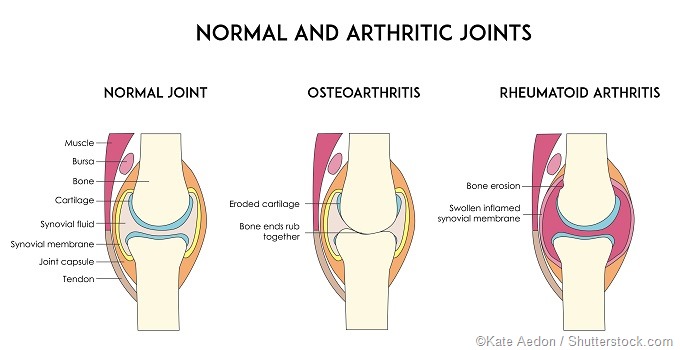
Osteoarthritis vs. Rheumatoid Arthritis – Understanding the Differences
By Lana Barhum
Arthritis is a general term to describe inflammation of the joints. However, there are different types of arthritis, including osteoarthritis (OA) and rheumatoid arthritis (RA). Although OA and RA both affect the joints and cause inflammation and joint pain, they are very different forms of arthritis.
Degenerative disease vs. autoimmune disease
Osteoarthritis is the most common forms of arthritis and a degenerative disease (disease in which deterioration of structure or function of tissue occurs). People with OA experience a breakdown in the cartilage that cushions the joints. The worn cartilage causes bones to rub against each other, resulting in pain.
OA may be the most common form of arthritis, but RA is the most crippling. Rheumatoid arthritis is also one of the most common forms of autoimmune arthritis. It is a chronic disease, causing pain, swelling, joint damage and limited motion and function in the affected joints. RA can affect any joint, but the small joints of the hands and feet seem to be most affected. Moreover, inflammation may affect organs, including the eyes, lungs, heart, and skin.

Prevalence
Osteoarthritis affects an estimated 27 million Americans, whereas rheumatoid arthritis affects 1.3 Americans. Both conditions are more common in women; 75% afflicted with RA are women. RA affects people between the ages of 30 and 60, but can start at any age, and even affect children. OA generally starts later in life and more common in older adults.
Causes
OA is the result of aging and risk factors, including injury, repetitive stress on joints, family history, and genetics. With RA, research has been aimed at the abnormal response of the immune system, but no specific cause is known. Theories look at triggering events and genetics but because RA affects people of all backgrounds, it is difficult to determine one specific cause.
Symptoms
Rheumatoid arthritis symptoms generally have a rapid onset over a short period of time; for example, a matter of weeks. Osteoarthritis symptoms develop slowly and gradually worsen over many years.
OA joint stiffness and pain are a result of inactivity or over activity, and not an autoimmune process. Further, pain and stiffness are worse at night for people with OA, and morning stiffness lasts less than 30 minutes. OA pain worsens after exercise and pressure on joints, and rubbing, grating or crackling noises are heard when afflicted joints are moved. Joints on one side of the body are worse and OA can also cause pain to the spine and hips.
RA is a systemic disease, usually affecting joints on both sides of the body equally, with the joints of the wrists, fingers, knees, feet and ankles most afflicted. The affected joints differentiate RA from OA, as OA typically affects the larger joints, such as in a knee, hip or shoulder, and not necessarily on both sides equally.
RA joint symptoms include, morning stiffness lasting more than one hour, pain on both sides of the body, and over time, joints may lose range of motion and become deformed. Non-joint symptoms are fevers, chest pain when breathing, dry eyes and mouth, fatigue and malaise, nodules on under the skin when the disease is more severe, numbness, tingling and/or burning of hands and feet, and sleep problems.
Diagnosis
OA is diagnosed with imaging tests, including x-rays and MRIs, looking for progressive joint damage and deterioration. A physical examination looks at affected joints for tenderness, redness, swelling and range of motion. Blood tests are done to rule out RA.
RA can be hard to diagnose because it may start out with subtle symptoms, such as achy joints or some morning stiffness, and those early symptoms can mimic other diseases. Early on, there is no single test to confirm an RA diagnosis. Rather, doctors will make the diagnosis by looking at the patient's symptoms, blood work, x-rays, and results from the physical exam.
Treatment
The goal of treatment for both RA and OA is to reduce pain, manage symptoms and halt further joint damage. Non-steroidal anti-inflammatory drugs (NAIDs) are prescribed to help with pain and to reduce swelling.
Osteoarthritis is also treated with steroid injections into affected joints for pain relief and restoration of function. Physical therapy helps to stabilize and strengthen joints. Heat, rest, weight reduction, and massage also help with pain management.
People with RA need stronger oral steroid medications, such as prednisone, to manage inflammation. They also use medications that prevent joint destruction and halt disease progression, including biologics and disease-modifying anti-rheumatic drugs, or DMARDs (Methotrexate). Biologics and DMARDs are known for their effectiveness, as well as their increased risk for side effects and infections.
Outlook
There is no cure for OA or RA. Because OA is degenerative, it will continue to get worse with time. But with appropriate treatment and lifestyle changes, including diet and exercise, most people can maintain a positive life outlook.
The outlook for RA is unpredictable, and numerous complications can arise from this autoimmune disease. And because RA is different for each patient, there is no general prognosis. However, many new treatments have been developed over the last 30 years that aim to lower inflammation, help with pain, prevent joint damage and halt the disease's progress. As a result, people with RA have a much better quality of life today than they did two decades ago.
Resources
- https://report.nih.gov/nihfactsheets/ViewFactSheet.aspx?csid=55
- http://www.rheumatology.org/I-Am-A/Patient-Caregiver/Diseases-Conditions/Rheumatoid-Arthritis
- http://www.mayoclinic.org/diseases-conditions/rheumatoid-arthritis/home/ovc-20197388
- http://www.mayoclinic.org/diseases-conditions/osteoarthritis/home/ovc-20198248
Further Reading
Last Updated: Aug 23, 2018






















.png)









No hay comentarios:
Publicar un comentario